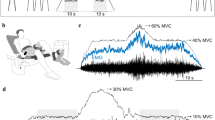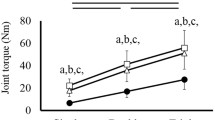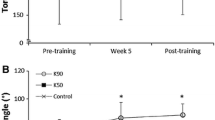Summary
Isokinetic ankle plantar- and dorsal-flexion torques, IPF and IDF, respectively, were measured in twenty-five physically healthy athletes, fifteen males and ten females, with simultaneous recording of rectified, linearly enveloped surface electromyograms, and peak electromyographic tensions (PEMG). Angular delays from the start of motion to occurrence of peak torques were also registered. Manoeuvres were performed in two knee positions. For comparison of strength 30 non-athletic (untrained) controls were included. IPF, but not IDF, was greater in the trained than in the untrained subjects. Formulae for estimation of IPF at 30‡ differ between trained and untrained subjects. Smaller gender differences in maximum strength for trained than for untrained subjects suggest that habitual rather than genetic dissimilarities cause sex differences in strength. Slope differences in the negative exponential models which characterize IPF and IDF as functions of increasing velocity of angular motion may be caused by different structural properties of ankle flexors and extensors. A lower PEMG of them. gastrocnemius in the flexed than in the extended knee positions can explain the lower IPFs, suggesting that mechanical rather than supraspinal factors cause postural IPF differences. In contrast, greater IDF in the flexed than in the extended knee position may indicate that neurogenic mechanisms are involved.
Similar content being viewed by others
References
AAOS. Am Acad Orthop Surg (1965) Joint Motion
Asmussen E, HeebØll-Nielsen K (1961) Isometric muscle strength of adult men and women. Comm Dan Natl Assoc Infant Par 5
Bigland B, Lippold OCS (1954) Motor unit activity in the voluntary contraction of human muscle. J Physiol 125: 322–335
Bobath B (1978) Adult hemiplegia: Evaluation and treatment. William Heineman, London
Boone DC, Azen SP (1979) Normal range of motion of joints in male subjects. J Bone Joint Surg 61-A: 756–759
Bouisset S (1973) EMG and muscle force in normal motor activities. In: Desmedt JE (ed) New developments in electromyography and clinical neurophysiology. Karger, Basel, pp 547–585
Bylund AC, Bjurö T, Cederblad G, Holm J, Lundholm K, Sjöström M, ängquist KA, Scherstén T (1977) Physical training in man. Skeletal muscle metabolism in relation to muscle morphology and running ability. Eur J Appl Physiol 36: 151–169
Ciba-Geigy (1970) Scientific tables. Basle, Switzerland
Chaffin DB, Lee M, Freivalds A (1980) Muscle strength assessment from EMG analysis. Med Sci Sports Exerc 12: 205–211
Costill DL, Jansson E, Gollnick PD, Saltin B (1974) Glycogen utilization in leg muscles of men during level and uphill running. Acta Physiol Scand 91: 475–481
Costill DL, Daniels J, Evans W, Fink W, Krahenbuhl G, Saltin B (1976) Skeletal muscle enzymes and fiber composition in male and female track athletes. J Appl Physiol 40: 149–154
Draper NR, Smith H (1966) Applied regression analysis. Wiley, New York
Edgerton VR, Smith JL, Simpson DR (1975) Muscle fibre type populations of human leg muscles. Histochem J 7: 259–266
Fick R (1911) Anatomie und Mechanik der Gelenke. Teil III, Spezielle Gelenk- und Muskelmechanik. Fischer, Jena
Fugl-Meyer AR, Burstedt Y, Långström M (1979a) Measurements of isokinetic ankle torques. In: Staff PH (ed) Proceedings of the Nordic workshop on physical medicine and rehabilitation. Syntex, Strömmen, pp 65–73
Fugl-Meyer AR, Sjöström M, Wählby L (1979b) Human plantar flexion strength and structure. Acta Physiol Scand 107: 47–56
Fugl-Meyer AR, Gustafsson L, Burstedt Y (1980) Isokinetic and static plantar flexion characteristics. Eur J Appl Physiol 45: 221–234
Gollnick PD, Sjödin B, Karlsson J, Jansson E, Saltin B (1974) Human soleus muscle: a comparison of fibre composition and enzyme activities with other leg muscles. Pflügers Arch 348: 247–255
Herman BR, Bragin SJ (1967) Function of the gastrocnemius and soleus muscles. Phys Ther 47: 105–113
Hof AL, Berg JW van den (1977) Linearity between the weighted sum of the EMGs of the human triceps surae and the total torque. J Biomech 10: 329–339
Johnson MA, Polgar J, Weightman D, Appelton D (1973) Data on the distribution of fibre types in thirty-six human muscles. An autopsy study. J Neurol Sci 18: 111–129
Mill JS (1970) The subjection of women. MIT Press, Cambridge
Millner-Brown HS, Stein RB (1975) The relation between the surface electromyogram and muscular force. J Physiol 246: 549–569
Moritani T, deVries H (1978) Reexamination of the relationship between the surface integrated electromyogram (IEMG) and force of isometric contraction. Am J Phys Med 57: 263–277
Murray MP, Guten GN, Baldwin JM, Gardner GM (1976) A comparison of plantar flexion torque with and without the triceps surae. Acta Orthop Scand 47: 122–124
Nelson AJ, Moffroid M, Whipple R (1973) The relationship of integrated electromyographic discharge to isokinetic contractions. In: Desmedt JE (ed) New developments in electromyography and clinical neurophysiology. Karger, Basel, pp 584–595
Sjöström M, Fugl-Meyer AR, Nordin G, Wählby L (1980) Post-stroke hemiplegia, crural muscle strength and structure. Scand J Rehabil Med [Suppl] 7: 53–67
Tardieu C, Colbeau-Justin P, Bret MD, Lespargot A, Huet de la Tour E, Tardieu G (1976) An apparatus and a method for measuring the relationship of triceps surae torques to tibio tarsal angles in man. Eur J Appl Physiol 35: 11–20
Taylor AW, Essén B, Saltin B (1974) Myosin ATPase in skeletal muscle of healthy men. Acta Physiol Scand 91: 568–570
Thorstensson A, Larsson L, Tesch P, Karlsson J (1977) Muscle strength and fibre composition in athletes and sedentary men. Med Sci Sports 9: 26–30
Wählby L (1978) Achilles tendon injury. Aspects on muscle structure and strength. Umeå University Medical Dissertations 38: 14–15
Author information
Authors and Affiliations
Rights and permissions
About this article
Cite this article
Fugl-Meyer, A.R. Maximum isokinetic ankle plantar and dorsal flexion torques in trained subjects. Europ. J. Appl. Physiol. 47, 393–404 (1981). https://doi.org/10.1007/BF02332967
Accepted:
Issue Date:
DOI: https://doi.org/10.1007/BF02332967




